The courageous Akita is known for its loyalty originally used as a working dog in Japan, typically hard to train. Carefully read about this breed’s personality.
Statistics
| Dog Breed Group | Purebred dogs |
| Height | 24 inches to 27 inches inches |
| Weight | 60 to 90 pounds |
| Life Span | 10 to 15 years |
Akita Dog
The Akita is a breed that exudes dignity and power, often referred to as a noble companion. Akita is a large dog commonly known as the Japanese dog breed or the Akita Inu. Characterized by its thick double coat that is weather-resistant. Originally used as working dogs and hunting large games such as bears or boars, Akita dogs are also used as guard dogs. These dogs are famous for their loyalty, courage, nobility, intelligence, and dignified demeanor.
These dogs are confident and bold with their unique appearance. They attract the hearts of many by their erect ears, upright curled tail, Large head as compared to small triangular eyes. These dogs are not perfect for families with small kids and other animals because Akitas are not friendly with stranger or other animals. Akita’s fox-like appearance and rich history differentiate it from all other dog breeds. This guide provides an in-depth look at everything you need to know about Akitas, from their history and characteristics to their care and training.
The noble Akita is prized for its loyalty and courage. Understanding the Akita breed is essential for potential owners, breeders, and dog enthusiasts. Akita dogs have unique needs and traits that make them different from other breeds, and knowing these can help ensure a happy and healthy relationship between the dog and its owner. Whether you’re looking for a family pet or a dedicated guardian, the Akita stands out as an impressive choice.
Adaptability
This breed surprisingly loving and kind to owners and their entire mission is to serve you throughout life. Akitas also love to chase their owners from room to room. Akitas adapt well to both city and country living, provided they get enough exercise. They thrive in environments where they can be active and have space to move around. A secure, fenced yard is ideal for giving them space to play and explore safely.
While Akitas can live outdoors in temperate climates, they prefer being close to their family and do best with a mix of indoor and outdoor time. They are social animals that thrive on companionship and interaction with their owners.
Akitas are well-suited to colder climates due to their thick double coat but can also adapt to warmer environments with proper care and hydration. In hot weather, provide plenty of water and shade, and avoid strenuous activities during peak heat hours.
Akita History
The Akita, a noble and powerful breed, originates from Japan’s mountainous Akita prefecture, where it was initially bred by the Matagi tribe for hunting large game. Over centuries, the Akita evolved through selective breeding, becoming a symbol of wealth and good fortune among Japanese nobility. Although cross-breeding in the late 19th century and the devastation of World War II impacted the breed, post-war efforts, particularly by American servicemen and figures like Helen Keller, revived the Akita’s popularity. This led to the establishment of breed standards, distinguishing the Japanese Akita from the American Akita. Today, Akitas are cherished worldwide for their loyalty, courage, and versatility, maintaining a revered status in Japan as symbols of loyalty and devotion.
According to the PADS Newsletter-30, during the war, some Akita were bred with German Shepherds to save them from slaughter. This and the breed’s mixed heritage from its fighting days gave the Akita of the time a distinctly different look from the other Japanese breeds. After the war, US servicemen stationed in Japan became interested in the breed, and many took dogs back with them. These Akita became the foundation of the breed in the US and overseas.
In Japan, however, a movement to return the Akita to its ‘original’ state started around this time. An extensive breeding program to select for preferred type began, leading to the creation of the modern Japanese Akita. In the United States, however, the larger, heavier boned Akita were preferred leading to two very different strains of this once single breed. Today in Japan the types have been split into two separate breeds, however, internationally, some kennel clubs still recognize them as one breed.
Akita’s Varieties
The Japanese Akita and the American Akita, while originating from the same breed, have distinct differences due to their separate development paths. The Japanese Akita, also known as Akita Inu, is known for its more fox-like features, including a narrower face, almond-shaped eyes, and erect ears. This breed has a rich history in Japan, where it was initially used for hunting large game such as bears. The Japanese Akita typically has a more refined and elegant appearance, with a coat that comes in various colors, including white, brindle, and red. They are often described as dignified, reserved, and loyal, forming strong bonds with their families.
On the other hand, the American Akita, which diverged from the Japanese breed after World War II, is generally larger and more robust. It has a bear-like face with a broader head and smaller, deeper-set eyes. The American Akita’s coat is denser and can come in a wider variety of colors and patterns, including pinto and black masks, which are not accepted in the Japanese standard. This breed tends to be more imposing and is known for its strength and protective nature. Both breeds are loyal and intelligent, but the American Akita may display more independence and territorial behavior. Despite these differences, both types of Akitas share a common ancestry and are celebrated for their loyalty, courage, and companionship.
Quick Facts of Akita
- Origin: Japan
- Size: Large
- Breed Group: Working Dog
- Average Lifespan: 10 to 15 years
- Coat: Thick double coat typically white, brown, brindle
- Temperament: loyal, courageous, dignified, intelligent, affectionate, reserved with strangers
- Grooming: Regular brushing and occasionally grooming is essential for coat health and appearance
- Training: early socialization is essential due to their independence nature
- Exercise Needs: Moderate exercise, playtime, regular walks essential
- Akita dog is not suitable for first-time owners because these dogs are tough to train.
Akita Characteristics
While Akita is a sweet and affectionate dog breed and loving with owners and other pets, but this breed is not suitable for families with children as these dogs are reserved and can’t tolerate stranger out of their sphere. Usually Akita don’t bark unless there is a good reason, but this breed is vocal and Akita’s owner says these dogs are intelligent and also give suggestion on all matters, this talkative ability make them them popular among many people.
| Affection Level | High |
| Friendliness | Low |
| Kids Friendly | Low |
| Pets Friendly | Low |
| Exercise Needs | High |
| Playfulness | High |
| Energy level | High |
| Trainability | Medium |
| Intelligence | Medium |
| Tendency to bark | Low |
| Amount of Shedding | High |
Appearance of Akita
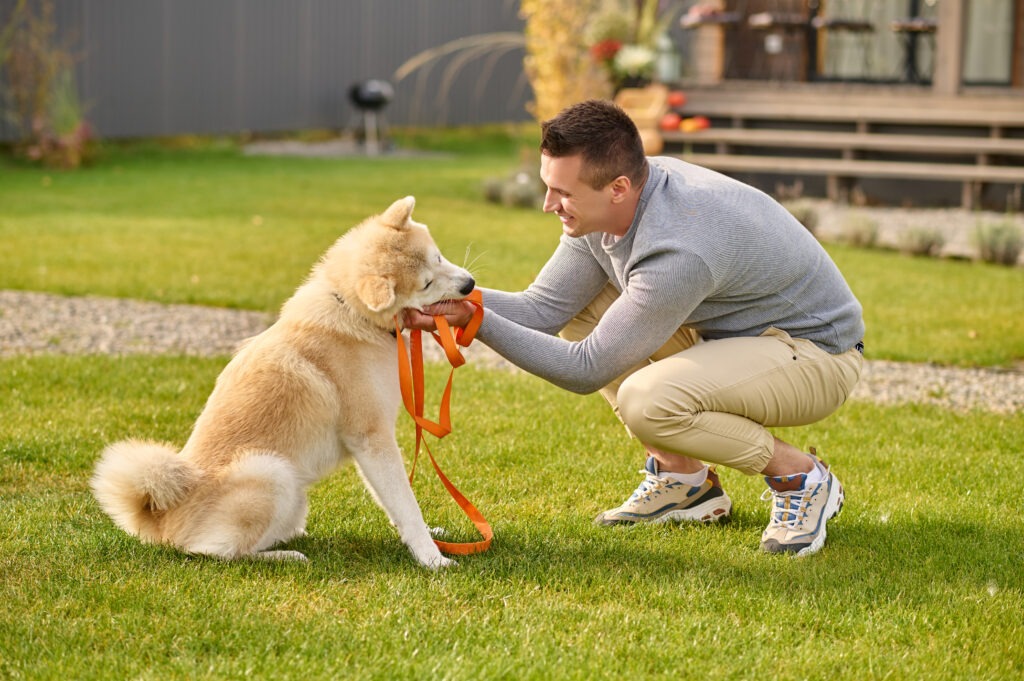
One of the most recognizable features of the Akita is its curled tail, which remains over the back. Their small, triangular eyes and erect ears add to their alert and confident appearance. These features, combined with their strong muscular build, give the Akita an imposing yet noble look.
The Akita’s double coat is an other distinctive feature. The outer coat is dense and straight, while the undercoat is soft and thick. They come in various colors, including white, brindle, and pinto, with some Akitas having striking facial markings. The variety in coat colors adds to their majestic appearance and makes each Akita unique.
Akita Size and Weight
Akitas are large dogs, with males typically weighing between 100 to 130 pounds and females ranging from 70 to 100 pounds. Their sturdy and muscular build is complemented by a dignified and balanced gait. This size makes them a commanding presence and excellent guardians.
Akita Temperament
Akitas are known for their loyalty and independence. They are often aloof with strangers but incredibly devoted to their families. This breed is famous for its bravery and protective instincts, making them excellent watchdogs. Their loyalty is unmatched, and they will go to great lengths to protect their loved ones.
Within the family, Akitas are affectionate and playful. They bond closely with their owners and enjoy being involved in family activities. However, they do best in homes where they can receive ample attention and exercise. Their playful nature makes them great companions, but they also appreciate quiet time with their family.
Akitas can be territorial and may not always get along with other pets, especially of the same sex. Early socialization is key to ensuring they can coexist peacefully with other animals. Their strong prey drive can sometimes lead to issues with smaller animals, so it’s essential to monitor their interactions closely.
Socialization
Exposing your Akita to various environments, people, and other animals from an early age can help in curbing their natural aloofness and ensuring they grow into well-rounded adults. Socialization should be a gradual process, starting with controlled interactions and slowly increasing the level of exposure.
Training
Starting training early is crucial for an Akita. Their independent nature can make them challenging to train if not handled with consistency and patience from a young age. Early training helps to establish boundaries and ensures that your Akita grows up to be a well-behaved adult.
Positive reinforcement methods work best with Akitas. Reward-based training helps in building a strong bond and encourages them to respond well to commands. Consistency and firmness are also essential. Training sessions should be kept short and engaging to maintain their interest.
Exercise Needs of Akita
Akitas are active dogs that require regular exercise to stay healthy and happy. A minimum of an hour of exercise per day is recommended, including walks, playtime, and mental stimulation. Lack of exercise can lead to behavioral issues and health problems.
Engage your Akita in activities like hiking, running, and agility training. They enjoy tasks that challenge them both physically and mentally. Interactive toys and puzzle games are also excellent ways to keep their minds sharp.
Regular exercise helps prevent obesity, promotes cardiovascular health, and reduces behavioral issues in Akitas by providing an outlet for their energy. A well-exercised Akita is a happy and well-behaved Akita.
Akita’s Grooming
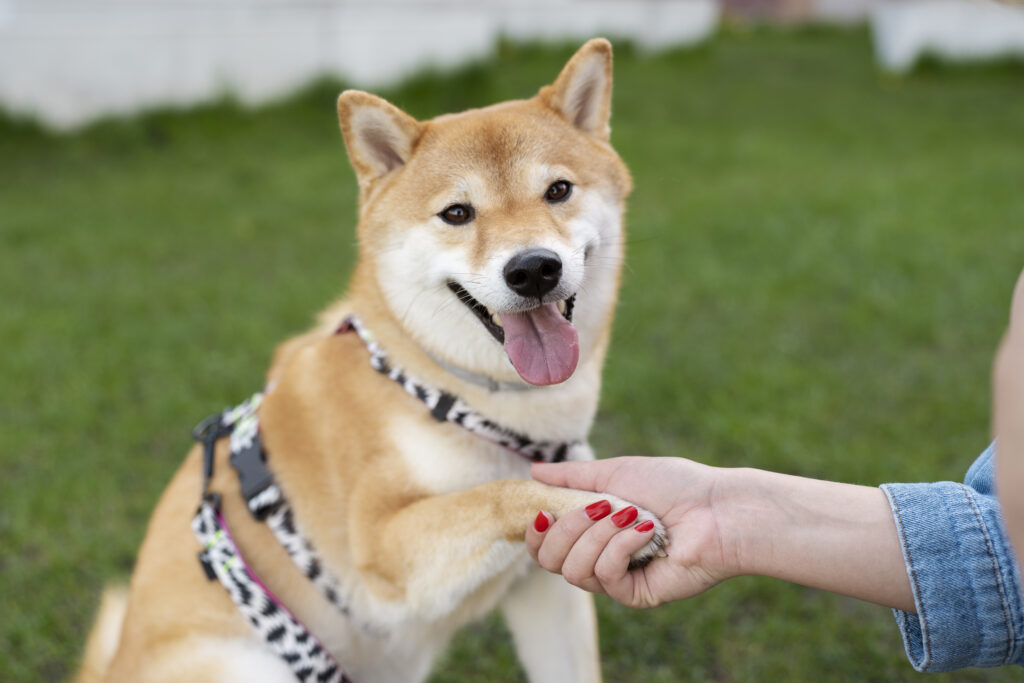
Regular brushing is necessary to manage the Akita’s shedding. Aim to brush your Akita at least once a week, and more frequently during shedding seasons. Bathing should be done every few months or as needed. Use a dog-specific shampoo to maintain their coat’s health and shine.
Keep your Akita’s nails trimmed to prevent discomfort and maintain mobility. Regularly check and clean their ears to prevent infections. Proper ear care can prevent issues like ear mites and infections, which can be common in dogs with erect ears.
Akitas shed heavily, especially during the spring and fall. Investing in a good vacuum cleaner and grooming tools can help manage the shedding around your home. Regular grooming sessions can also help reduce the amount of loose hair and keep your Akita’s coat looking its best.
Diet and Nutrition
A balanced diet rich in high-quality proteins, fats, and carbohydrates is essential for an Akita’s health. Consult with a veterinarian to determine the best diet plan for your dog. Fresh water should always be available, and portion control is crucial to prevent obesity.
Akitas are prone to food allergies and sensitivities. It’s important to monitor their diet closely and avoid common allergens such as soy, corn, and wheat. Signs of allergies can include itching, digestive issues, and ear infections.
Consider adding supplements like fish oil for a healthy coat and joints. Treats should be given in moderation and should complement their main diet. High-quality treats can be used as training rewards and to reinforce positive behavior.
Common Health Issues
Akitas are a robust and noble breed of dog, known for their strength, loyalty, and distinct appearance. However, like all breeds, they are prone to certain health issues. Being aware of these potential problems can help owners provide better care and take preventive measures to ensure their Akitas live long, healthy lives. Here are some of the common health issues that affect Akitas:
1. Hip Dysplasia
Hip dysplasia is a genetic condition where the hip joint does not fit properly into the hip socket. This can lead to pain, arthritis, and mobility issues as the dog ages. Regular exercise, maintaining a healthy weight, and in severe cases, surgery, can help manage this condition.
2. Hypothyroidism
Hypothyroidism is a condition where the thyroid gland does not produce enough hormones. Symptoms include weight gain, lethargy, hair loss, and skin problems. It can be managed with daily medication and regular blood tests to monitor thyroid levels.
3. Progressive Retinal Atrophy (PRA)
PRA is a group of genetic diseases that cause the retina to deteriorate over time, leading to blindness. There is no cure, but early diagnosis can help owners manage the condition and make adjustments to their dog’s environment to keep them safe.
4. Gastric Dilatation-Volvulus (GDV)
Also known as bloat, GDV is a life-threatening condition where the stomach fills with gas and twists on itself. This can cut off blood flow and requires immediate veterinary attention. Preventive measures include feeding smaller, more frequent meals and avoiding vigorous exercise right after eating.
5. Autoimmune Disorders
Akitas are prone to autoimmune disorders such as systemic lupus erythematosus (SLE) and pemphigus, which cause the immune system to attack the body’s own tissues. Symptoms vary widely but can include skin lesions, joint pain, and organ dysfunction. Treatment typically involves immunosuppressive drugs.
6. Von Willebrand’s Disease
This is a genetic bleeding disorder caused by a deficiency in a protein needed for blood clotting. Symptoms include excessive bleeding from minor injuries, nosebleeds, and prolonged bleeding during surgery. While there is no cure, management includes careful monitoring and avoiding injuries.
7. Sebaceous Adenitis
Sebaceous adenitis is an inflammatory disease that destroys the sebaceous glands in the skin, leading to hair loss, scaly skin, and secondary infections. Treatment often includes special shampoos, fatty acid supplements, and medications to reduce inflammation and infection.
8. Hypoadrenocorticism (Addison’s Disease)
This endocrine disorder results from the adrenal glands producing insufficient hormones. Symptoms include vomiting, diarrhea, lethargy, and poor appetite. Addison’s disease can be managed with hormone replacement therapy and regular veterinary monitoring.
9. Uveitis
Uveitis is an inflammation of the uvea, the middle layer of the eye. It can be caused by infections, trauma, or autoimmune disease. Symptoms include eye redness, pain, and vision problems. Treatment typically involves anti-inflammatory medications and addressing the underlying cause.
10. Patellar Luxation
Patellar luxation occurs when the kneecap dislocates or moves out of its normal position. It can cause lameness and pain. In mild cases, physical therapy and weight management can help, while severe cases may require surgical intervention.
By staying informed about these common health issues and working closely with a veterinarian, Akita owners can ensure their dogs receive the best possible care and enjoy a healthy, happy life.
Where to Adopt or Buy
Adopting an Akita can be a rewarding experience. Research rescue organizations and prepare your home for a new dog. The adoption process usually involves an application, home visit, and adoption fee. Rescued Akitas often come with a history that may require patience and understanding.
Rescuing an Akita provides a loving home to a dog in need. It can be a fulfilling experience knowing you are giving a second chance to a deserving pet. Many rescue organizations provide support and resources to help you and your new dog adjust.
Consider the time, effort, and resources required to care for an Akita. Ensure you are ready for the commitment before adopting. Understand that rescued dogs may have special needs and may require additional training and patience.
Summary
Owning an Akita can be a rewarding and fulfilling experience. These loyal and majestic dogs bring joy, protection, and companionship to their families. By understanding their needs and providing proper care, you can ensure a happy and healthy life for your Akita. Their loyalty and intelligence make them exceptional companions for those willing to invest the time and effort required to care for them properly.
FAQs
How much exercise does an Akita need?
Akitas require at least an hour of exercise daily, including walks, playtime, and mental stimulation. Regular exercise is essential to keep them healthy and prevent behavioral issues.
Are Akitas good with kids?
Yes, Akitas can be good with kids when properly socialized and supervised. They are protective and loyal, making them great family companions.
What should I feed my Akita?
A balanced diet rich in high-quality proteins, fats, and carbohydrates is recommended. Consult with a vet for specific dietary needs. Fresh water should always be available.
How often should I groom my Akita?
Regular brushing is needed at least once a week, with more frequent grooming during shedding seasons. Bathing should be done every few months or as needed.
What health issues are common in Akitas?
Common health issues include hip dysplasia, hypothyroidism, and autoimmune disorders. Regular vet check-ups are important for early detection and treatment.
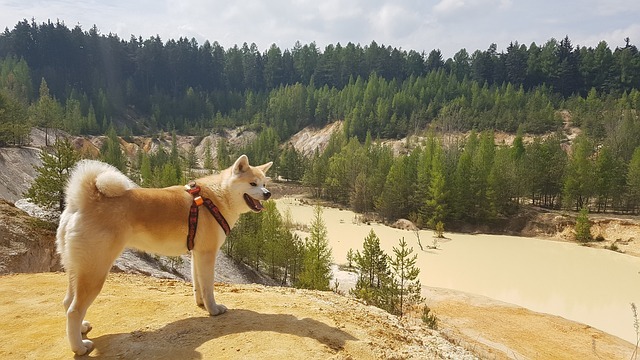

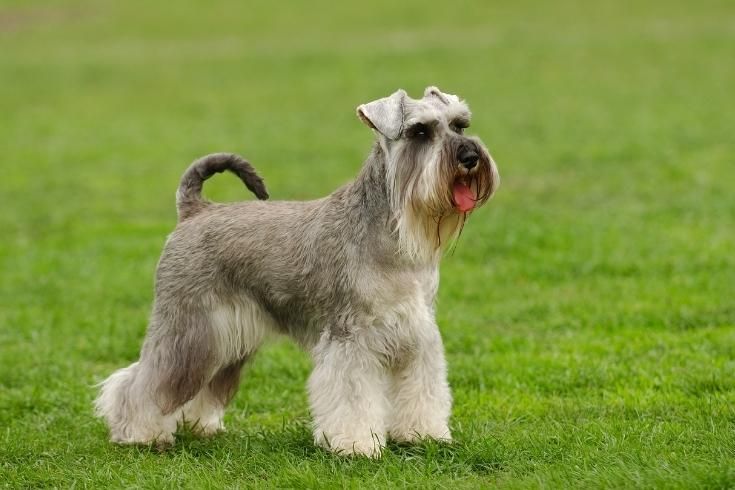
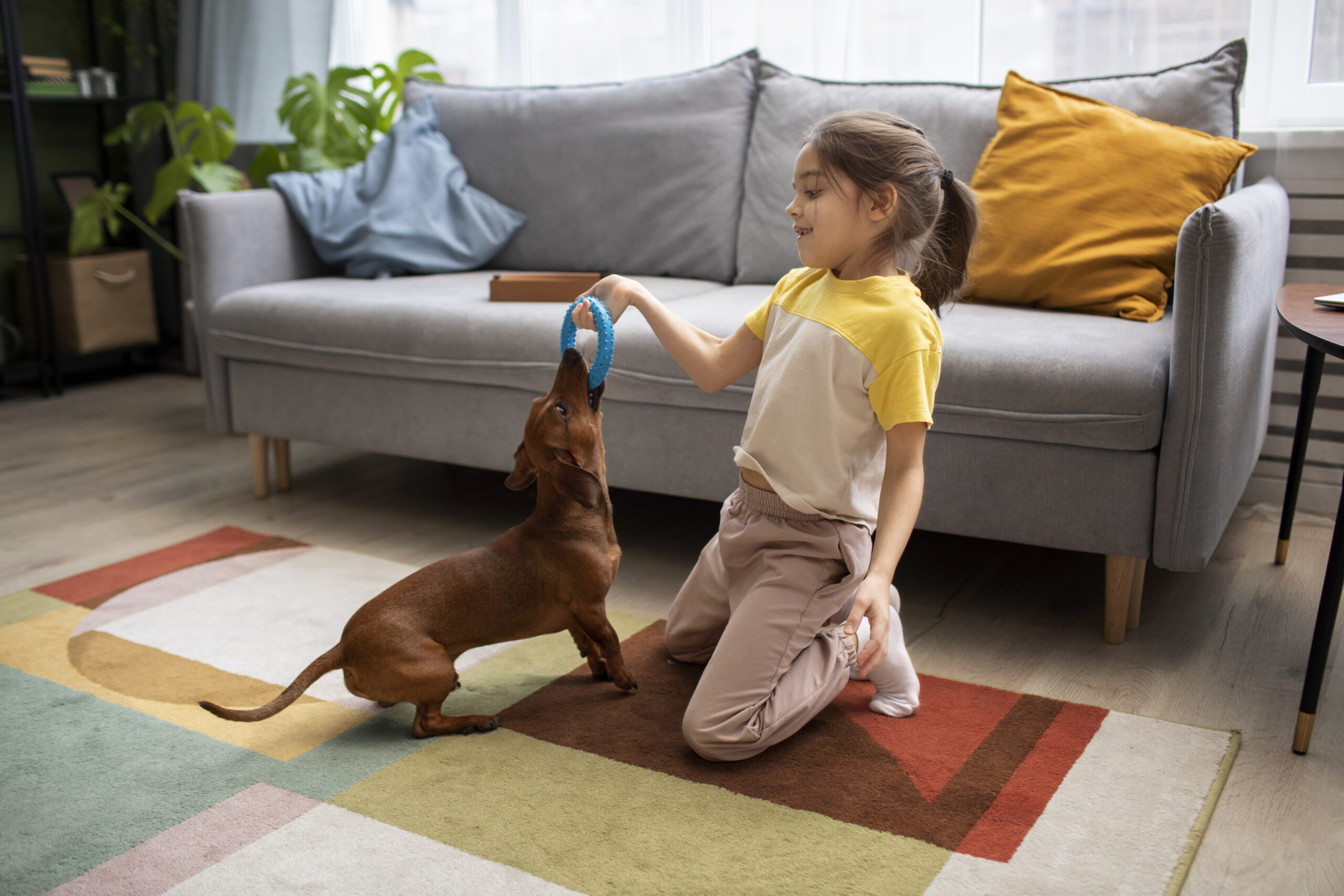
Your article helped me a lot, is there any more related content? Thanks!
Thanks for sharing. I read many of your blog posts, cool, your blog is very good.